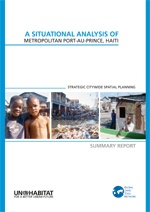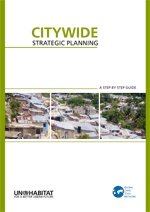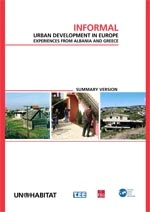FIG Cooperation with UN-HABITAT and the Global Land Tool Network
- President Enemark at the GLTN International Advisory Board Meeting
Nairobi, Kenya, 29-30
October 2010
|
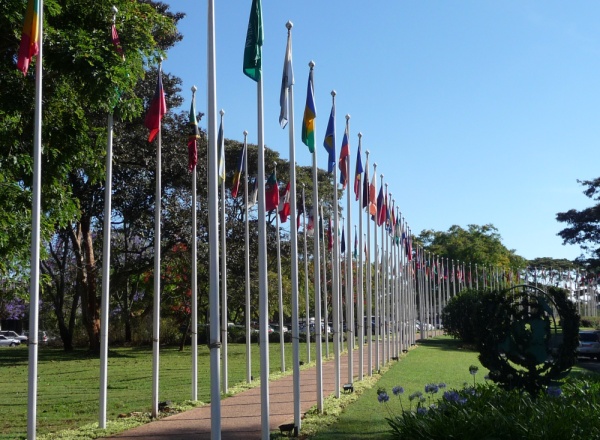
The flag alley entrance to the UN-HABITAT Headquarters at Gigiri,
Nairobi. |
FIG President Stig Enemark attended the Meeting of the Global Land
Tool Network (GLTN) International Advisory Board (IAB) held 29 October 2010
at the UN-HABITAT Headquarters in Nairobi, and followed by discussions 30
October on future co-operation and partnership between GLTN and FIG.
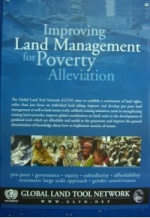 |
The Global Land Tool Network’s (GLTN) was established in 2006 with
the main objective of contributing to poverty alleviation and the
Millennium Development Goals through land reform, improved land
management and security of tenure. The GLTN has developed a global
partnership on land issues pulling together global partners, as well
as many individual members. To meet the overall objective, the GLTN
partners have identified and agreed upon the 18 key land tools which
need to be addressed in order to deal with poverty and land issues
at the country level, across all regions. The partners of GLTN argue
that the existing lack of these tools, as well as land governance
issues, are the main cause of failed implementation at scale of land
policies worldwide. See GLTN website
www.gltn.net where the tools and themes are described at
http://www.gltn.net/en/themes-and-issues.html |
The GLTN International Advisory Board (IAB) is established to provide
objective advice on issues related to the GLTN policies, operational
strategies and projects. The IAB meets once or twice a year to discuss
current progress and future strategies. The full IAB is available at:
www.gltn.net/index.php?option=com_content&task=view&id=18&Itemid=63
.
|
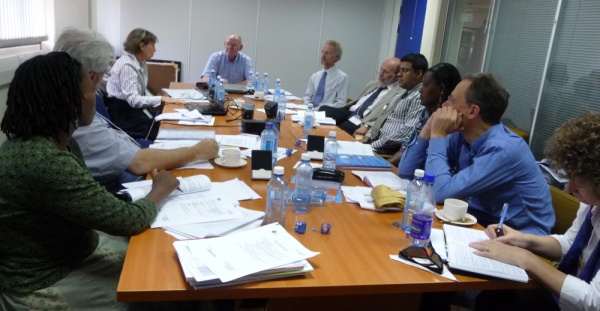
The IAB meeting was chaired by President Enemark (center). Next to
the left is Clarissa Augustinus, Chief UN-HABITAT Land,
Tenure and Property Administration Section. |
The key issue of the IAB meeting included a comprehensive evaluation
of the overall GLTN activities and achievements for the period
January-August 2010 based on the semi-annual progress and financial
report, September 2010. The presentation and discussions revealed that
GLTN has been very successful in achieving their goals and also that the
GLTN partners are very committed in their support. A range of pro-poor
land tools has been developed that are now being tested at country level
and at scale. Also a number of publications have been published in
cooperation with partners to provide guidelines on pro-poor land policy
implementation.
The Social Tenure Domain Model has a high priority at the GLTN
agenda. This work is undertaken in cooperation between GLTN, FIG, ITC
and the World Bank, and with Chrit Lemmen (Chair of FIG WG 7.1)
as a key driver. The STDM is seen as critical for recording a wide range
of informal land rights and claims. Without such alternatives to the
conventional cadastral systems, pro-poor land policies will remain
virtually impossible to implement. The STDM concept and the prototype
have received enormous support and positive feedback from various
stakeholders. Next step is to improve and customise the prototype for
possible use in informal settlements and develop further to a fully
functional system. Moreover, some software developers are now pursuing
the development of simple and cheap software following the same
principles behind the development of STDM. The STDM was launched at the
FIG Congress in Sydney through FIG Publication no 52, see:
http://www.fig.net/pub/figpub/pub52/figpub52.htm
GLTN has also developed with partners (FIG, Huairou Commission and
University of East London) a Gender Evaluation Criteria land tool that
assesses whether a large-scale land tool or programme is responsive to
both women and men's needs. The evaluation criteria were pilot-tested in
three countries Brazil, Nepal and Ghana by Diane Dumashie, Chair
of FIG Commission 8, and the results were highlighted in a Roundtable
discussion at the World Urban Forum V in Rio de Janeiro in March 2010.
Training activities around these criteria are planned to take place in a
range of countries to facilitate implementation and use for government,
professionals and grass root organisations. The gender Evaluation
criteria are available at:
http://www.gltn.net/en/home/gender/gender-evaluation-brochure/details.html
A full GLTN Midterm Assessment Report for the period 2007-2009 is
available at:
http://www.unhabitat.org/downloads/docs/8502_98906_GLTN_Midterm_assessment.pdf
The IAB also discussed on the future strategies for taking the GLTN
agenda forward in a close cooperation with partners. This also relates
to the ongoing transition in administration of UN-HABITAT (see below) as
well as possible changes in the funding streams for the GLTN activities.
Next IAB meeting will be held during the 23rd Session of the Governing
Council of UN-HABITAT in April 2011.
Recent publications published by UN_HABITAT, Global Land Tool
Network. Note the publication on Informal Urban Development in Europe
produced in cooperation with FIG and with Chryssy Potsiou,
incoming FIG Vice-President, as the key author. All publications are
available online at GLTN website: http://www.gltn.net
The following day on Saturday 31 October President Enemark had
meetings with Clarissa Augustinus, Head of GLTN and Chief
UN-HABITAT Land, Tenure and Property Administration Section, and the key
staff of GLTN, Danilo Antonio, Remy Sietchping, and Solomon
Haile. Discussions were around future cooperation and activities in
relation to pursuing the GLTN agenda as well as the objectives of FIG.
Capacity Building for good governance and implementation of pro-poor
land policies will be key issues. President Enemark conveyed the best
regards from the incoming President Chee Hai Teo and ensured that
continuous strong commitment of FIG in support of the GLTN agenda will
be part of the council work plan for the period 2011-14.
Change of Executive Director of UN-HABITAT
UN-HABITAT is currently in a state of transition due to the change
the Executive Director. Dr. Joan Clos, the former Mayor of
Barcelona, Spain, is succeeding Dr. Anna Tibaijuka who has headed
UN-HABITAT since it was formed in 2001 to replace the UN Centre for
Human Settlements (UNCHS). Dr. Anna Tibaijuka is also well known to FIG
as a keynote speaker – latest at the FIG Working Week in Stockholm, June
2008. Dr. Joan Clos started his tenure as Executive Director 18 October
2010 for a period of four year. He is known as a committed advocate of
the urban agenda, and as Mayor of Barcelona he became world famous for
the way he turned around the fortunes of the city. Read more:
http://www.unhabitat.org/content.asp?cid=8768&catid=5&typeid=6&subMenuId=0
|
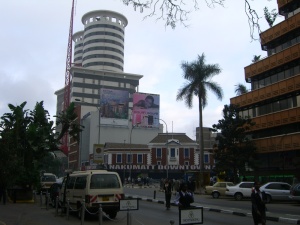 |
 |
|
Images from down town Nairobi with the famous two round towers
(left), and the National Archives building with the busy coach
concourse (right). |
|

The Nairobi National Park is located just outside the city and
provides good and easy opportunity for game watching - here a lion
family in the late afternoon twilight. |
19 November 2010
|


























